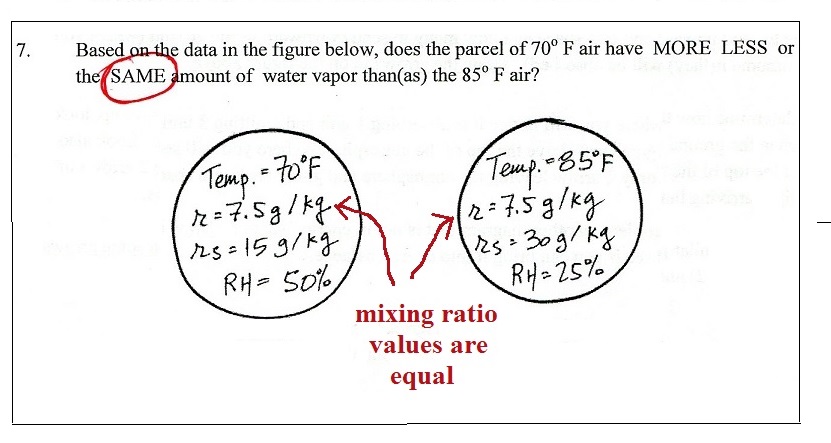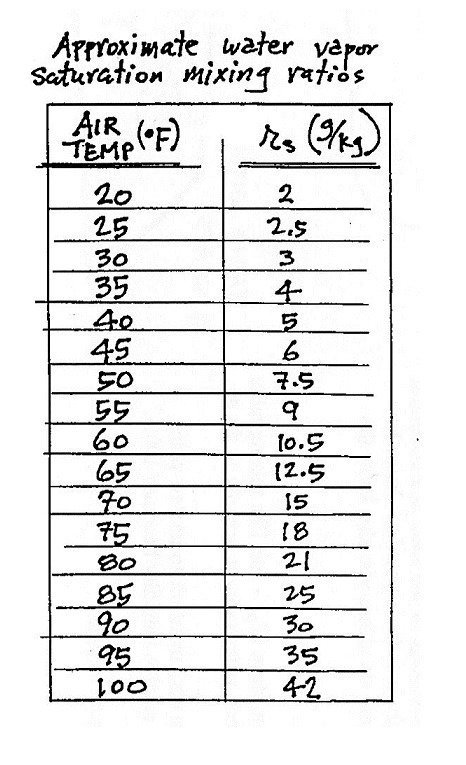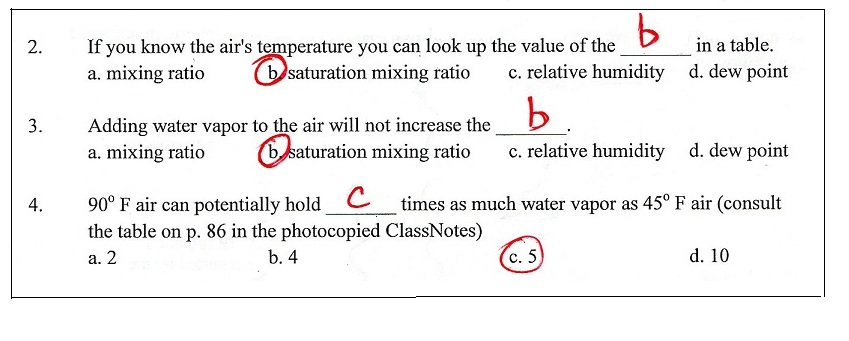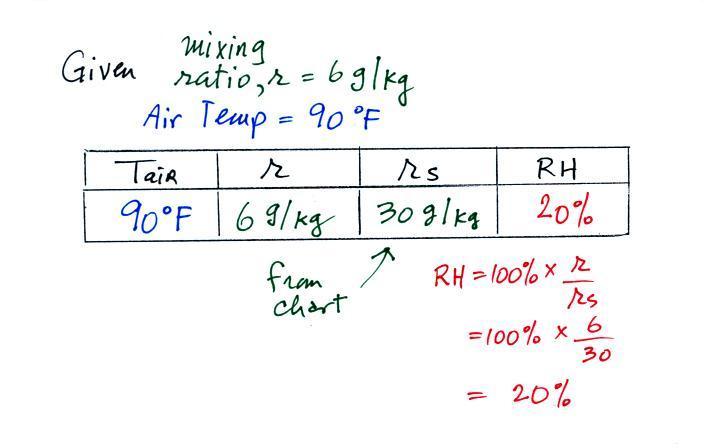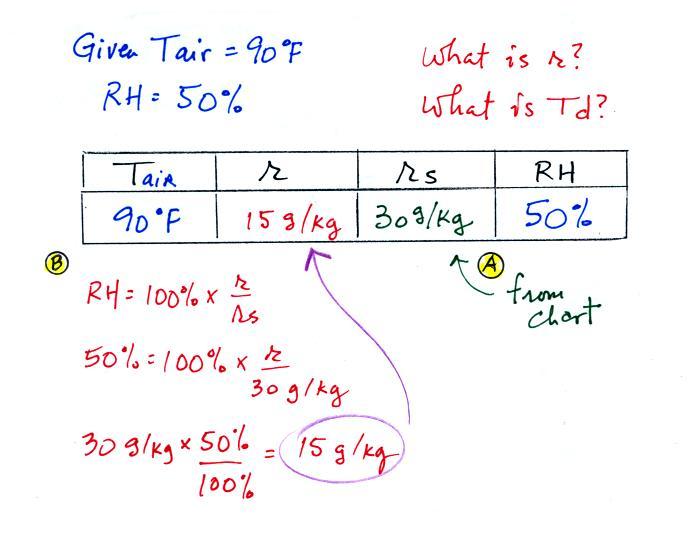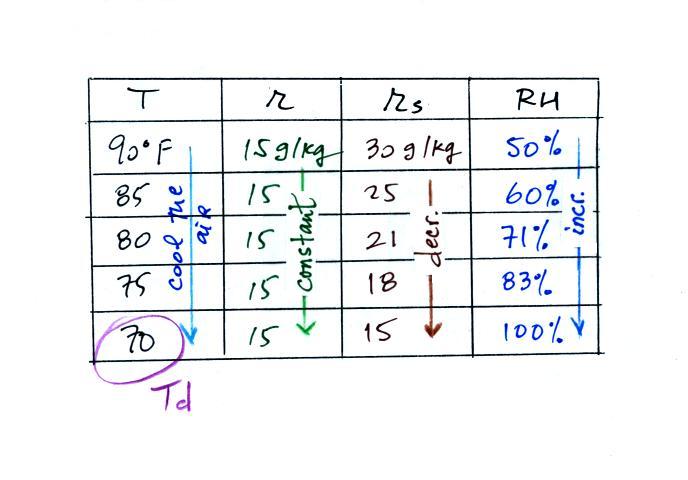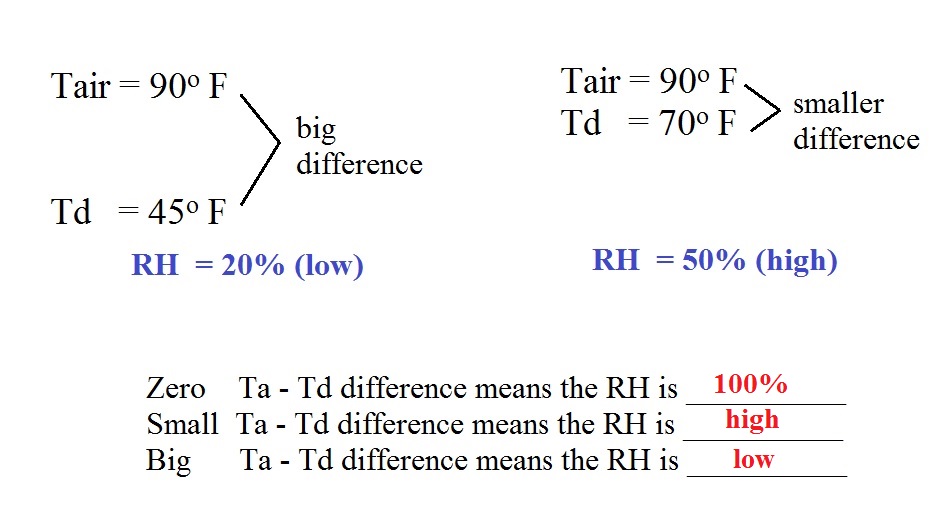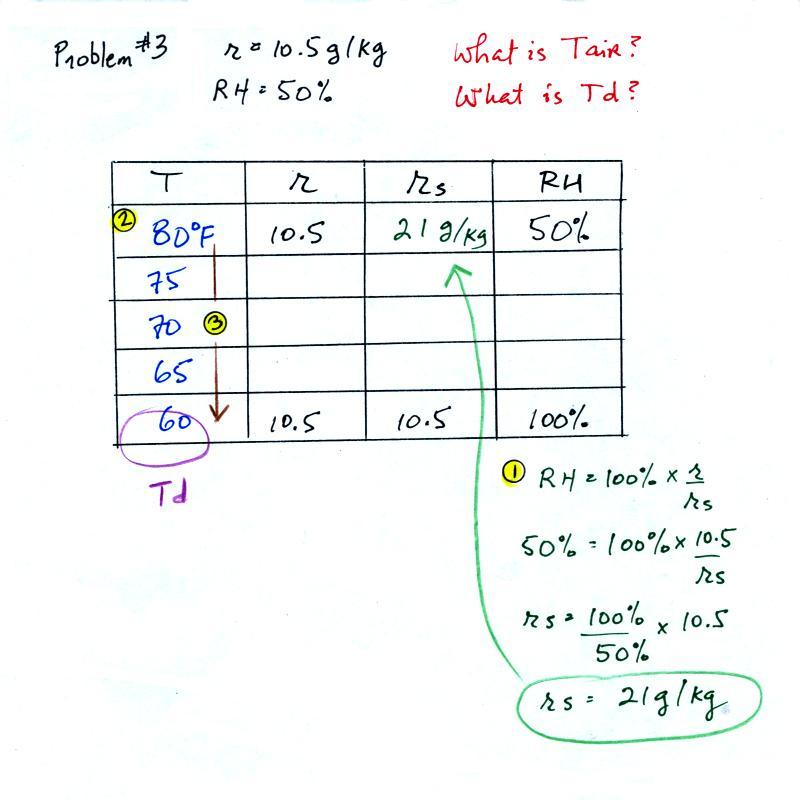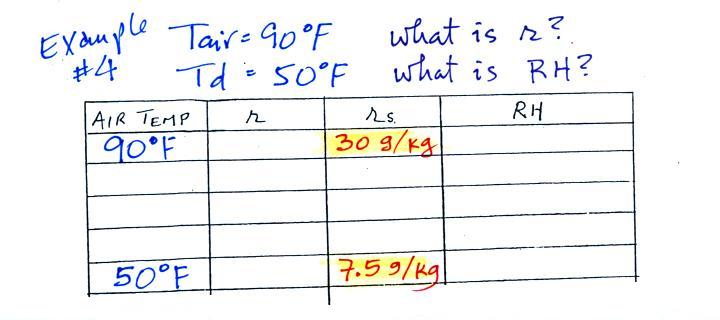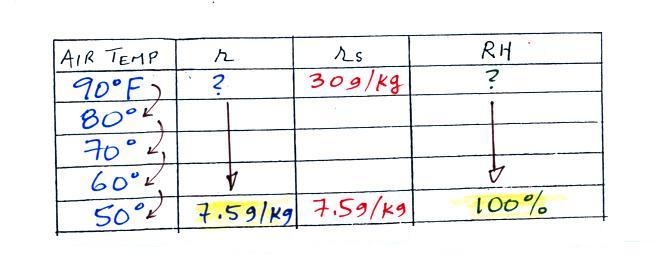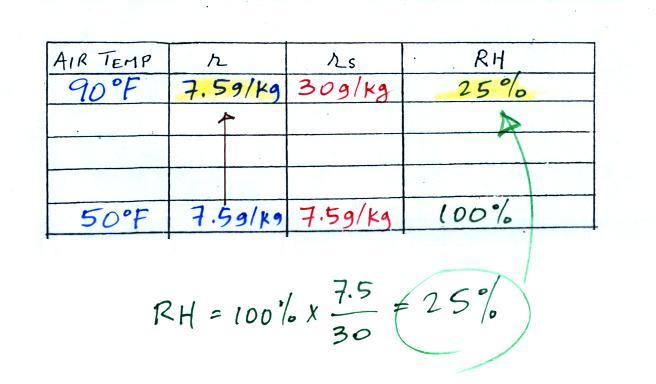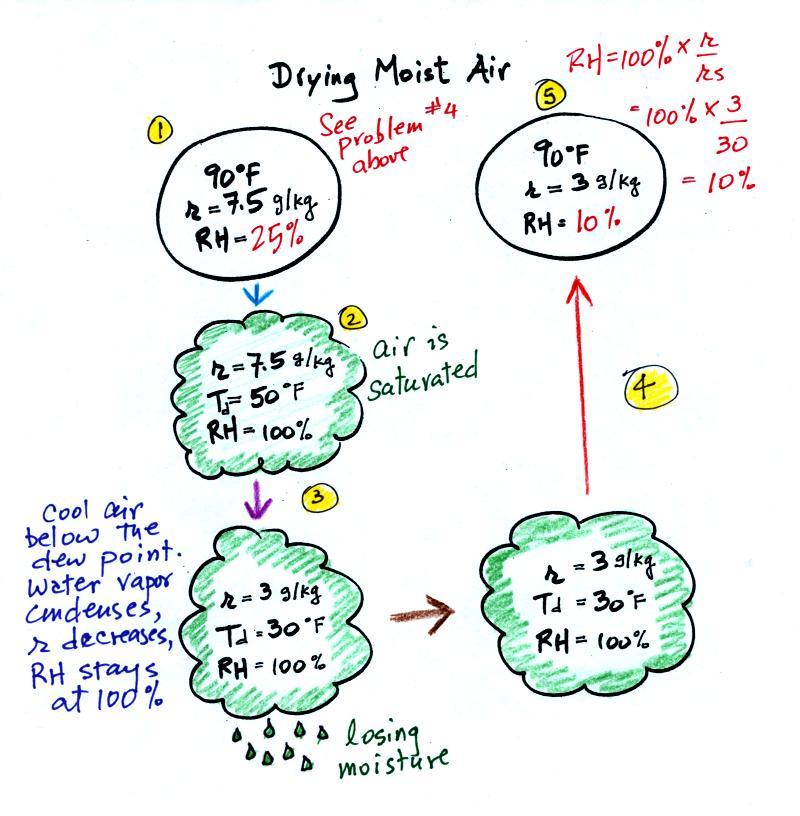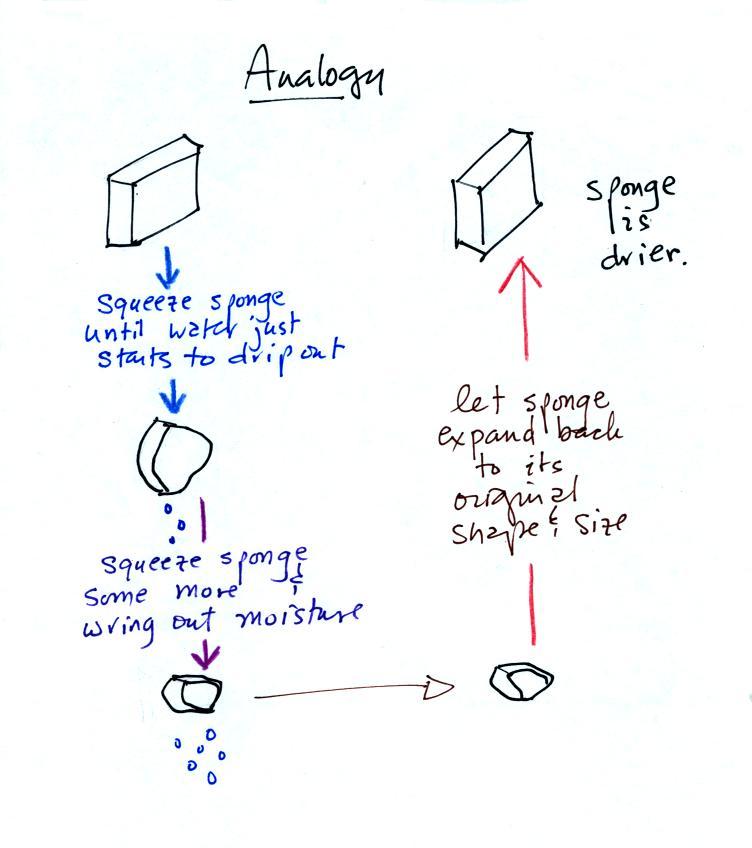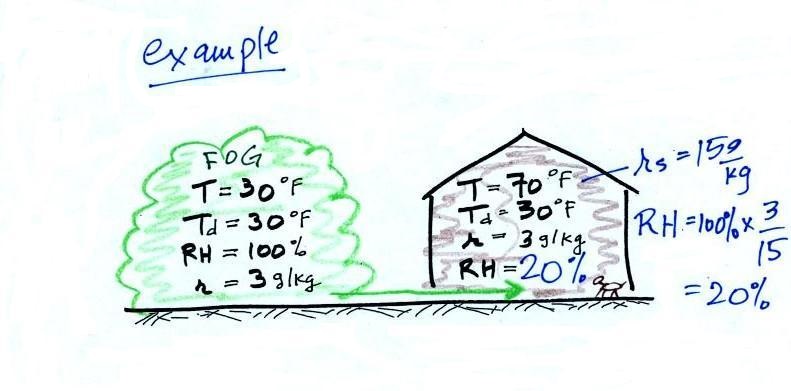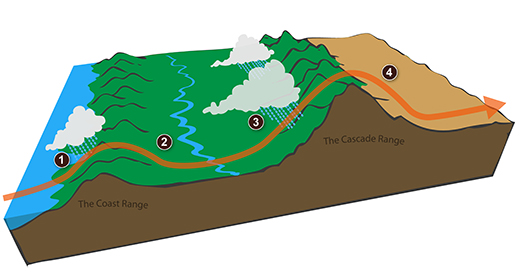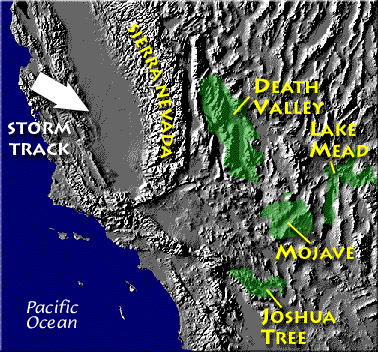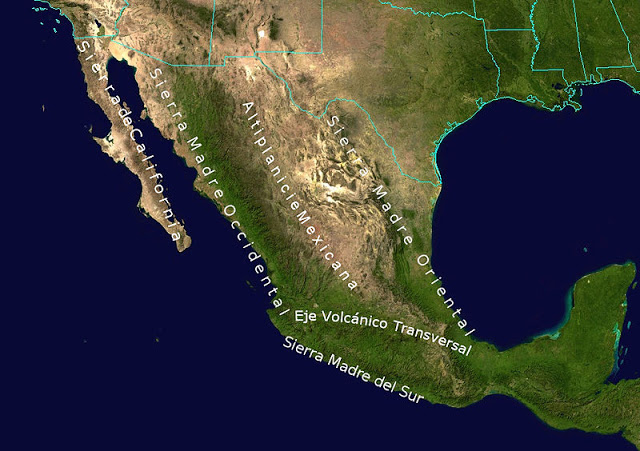The relative humidity really doesn't tell you how
much water vapor is actually in the air.
4.
The dew point temperature has a couple of
jobs. Here's the one we'll be using today
Cooling air doesn't change the mixing
ratio. As you cool air the saturation mixing ratio
decreases. Eventually the values of the mixing ratio and
saturation mixing ratio become equal and the RH becomes 100%.
This is the dew point's other job. One of the example
problems will try to show that if you know the dew point
temperature you can easily figure out the mixing ratio and
vice versa.
Humidity example problem #1
There are 4 humidity variables
(mixing ratio, saturation mixing ratio, relative
humidity, and dew point temperature).
Generally I'll give you values for two of them and
you'll need to figure out values for the other
two.
Here are the starting conditions for this first
problem
Tair = 90 F
|
r = 6 g/kg
|
RH = ?
|
Td = ?
|
We start by entering the data we were given
Anytime you know the air's temperature
you can look up the saturation mixing ratio value on a chart
(such as the one on p. 86 in the ClassNotes); the saturation
mixing ratio is 30 g/kg for 90 F air. 90 F air could
potentially hold 30 grams of water vapor per kilogram of dry
air (it actually contains 6 grams per kilogram in this
example).
Once you know mixing ratio and saturation mixing ratio
you can calculate the relative humidity (you divide the
mixing ratio by the saturation mixing ratio, 6/30, and
multiply the result by 100%). You ought to be able to
work out the ratio 6/30 in your head (6/30 = 1/5 =
0.2). The RH is 20%.
The numbers we just figured out are shown on the top line
below.
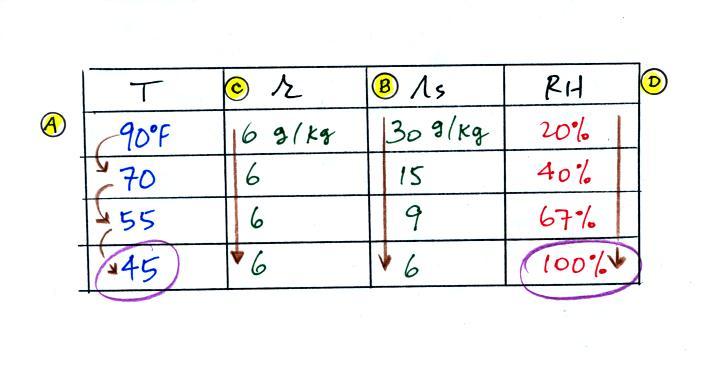
(A) To figure out the dew point, we imagine cooling the
air from 90F to 70F, then to 55F, and finally to 45F.
Note the effect this has on the mixing ratio, the saturation
mixing ratio and the relative humidity.
(B) At each step we looked up the saturation mixing
ratio and entered it on the chart. Note that the
saturation mixing ratio values decrease as the
air is cooling.
(C) The mixing
ratio (r) doesn't change as we cool the air.
The only thing that changes r is adding or removing water
vapor and we aren't doing either. This is probably the
most difficult concept to grasp.
(D) Note how the relative humidity is increasing as we
cool the air. The air still contains the same amount
of water vapor it is just that the air's capacity is
decreasing.
Finally at 45 F the RH becomes 100%. This is the
dew point. The dew point temperature is 45 F
What would happen if we cooled the air below the dew
point temperature?
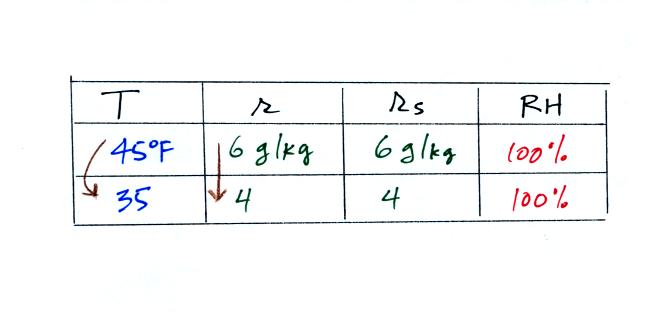
35 F air can't hold the 6 grams of water
vapor that 45 F air can. You can only "fit" 4 grams of
water vapor into the 35 F air. The remaining 2 grams
would condense. If this happened at ground level the
ground would get wet with dew. If it happens above the
ground, the water vapor condenses onto small particles in
the air and forms fog or a cloud. Because water vapor
is being taken out of the air (the water vapor is turning
into water), the mixing ratio will decrease from 6 g/kg to 4
g/kg. As you cool air below the dew point, the RH
stays constant at 100% and the mixing ratio decreases.
This is the situation where cooling the air seems to be
affecting the value of the mixing ratio. But it's
because we're cooling the air below the dew point and water
vapor is condensing. The air is actually losing water
vapor and the mixing ratio (whose job it is to tell you how
much water vapor is in the air) should decrease.
In many ways cooling moist air is liking squeezing
a moist sponge
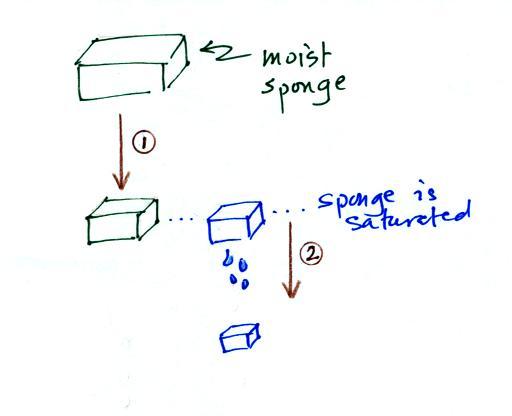
Squeezing the sponge and reducing its
volume is like cooling moist air and reducing the saturation
mixing ratio. At first (Path 1 in the figure) when you
squeeze the sponge nothing happens, no water drips
out. Eventually you get to a point where the sponge is
saturated. This is like reaching the dew point.
If you squeeze the sponge any further (Path 2) water will
begin to drip out of the sponge (water vapor will condense
from the air).
Humidity example problem #2
Tair = 90 F
|
r =
?
|
| RH = 50% |
Td =
?
|
The problem is worked out in detail below
First you fill in the air temperature and the RH data
that you are given.
(A) since you know the air's temperature you can look up the
saturation mixing ratio (30 g/kg).
(B) Then you might be able to figure out the mixing
ratio in your head. Air that could hold up to 30 g/kg
of water vapor is filled to 50% of its capacity. Half
of 30 is 15, that is the mixing ratio. Or you can
substitute into the relative humidity formula and solve for
the mixing ratio. The details of that calculation are
shown above at B.
Finally you imagine cooling the air (I added more intermediate temperatures
in the table above than we use in class).
Notice how the saturation mixing ratio decreases, the mixing
ratio stays constant, and the relative humidity increases as
the air is cooled. In this example the RH
reached 100% when the air had cooled to 70 F. That is
the dew point temperature.
What
does the difference Tair - Td tell you about the
relative humidity?
We
can use results from humidity problems #1
and #2 to learn and understand a useful
rule.
In the first example the difference between the air and
dew point temperatures was large (45 F) and the RH was low
(20%).
In the 2nd problem the difference between the air and dew
point temperatures was smaller (20 F) and the RH was higher
(50%).
The easiest way to remember this rule might be to remember
the case where there is no difference between the air and
dew point temperatures.
The RH then would be 100%.
We'll probably skip the next
problem in class but I'll include it here in the
notes.
Humidity example problem #3
Tair
= ?
|
r = 10.5 g/kg
|
| RH = 50% |
Td =
?
|
You're given the the mixing ratio = 10.5 g/kg and a
relative humidity of 50%. You
need to figure out the air temperature and the dew point
temperature. Give it a try. A step by
step solution is given below:
(1) The air contains 10.5 g/kg of water vapor. This is
50% (half) of what the air could potentially hold. So
the air's capacity, the saturation mixing ratio must be 21
g/kg (you can either do this in your head or use the RH
equation following the steps shown above).
(2) Once you know the saturation mixing ratio you can look
up the air temperature in a table (80 F air has a saturation
mixing ratio of 21 g/kg)
(3) Then you imagine cooling the air until the RH becomes
100%. This occurs at 60 F. The dew point is 60 F
One of the "jobs" of the dew point, to give
you an idea of the actual amount of water vapor in the
air, is the same as the mixing ratio. The next
problem will demonstrate that if you know the dew point
temperature you can quickly figure out the mixing ratio
and vice versa.
Humidity example problem #4
Tair = 90 F
|
r =
?
|
RH =
?
|
Td = 50 F
|
One of the dew
point's jobs is the same as the mixing ratio - it
gives you an idea of the actual amount of water
vapor in the air. This problem will show that
if you know the dew point, you can quickly figure
out the mixing ratio and vice versa. Knowing
the dew point is equivalent to knowing the mixing
ratio.
We enter the two temperatures given on a chart and look up
the saturation mixing ratio for each.
We ignore the fact that we don't know the mixing
ratio. We do know that if we cool the 90 F air to 50 F
the RH will become 100%. So on the 50 F row, we can
set the mixing ratio equal to the value of the saturation
mixing ratio at 50 F, 7.5 g/kg. The two have to be
equal in order for the RH to be 100%.
Remember back to the three earlier examples.
When we cooled air to the the dew point, the mixing ratio
didn't change. So the mixing ratio must have been 7.5
all along. Once we know the mixing ratio in the
90 F air it is a simple matter to calculate the relative
humidity, 25%.
Drying moist air
The figure below is on p. 87 in the photocopied
ClassNotes. It explains how you
can dry moist air.
At Point 1 we start with some 90 F air with a relative
humidity of 25%, fairly dry air. These are the same
numbers that we had in Example Problem #4. We imagine
cooling this air to the dew point temperature, 50 F.
While doing that the mixing ratio, r, would stay
constant. Relative humidity would increase and
eventually reach 100%. A cloud would form (Pt. 2 in
the figure above).
Then we continue to cool the air below the dew point, to 30
F. Air that is cooled below the dew point finds itself
with more water vapor than it can contain. The excess
moisture must condense (we will assume it falls out of the
air as rain or snow). Mixing ratio will decrease, the
relative humidity will remain 100%. When air reaches
30 F it contains 3 g/kg, less than half the moisture that it
originally did (7.5 g/kg).
The air is being warmed back up to 90 F along Path 4.
As it warms the mixing ratio remains
constant. Cooling moist air raises the RH.
Warming moist air, as is being down here, lowers the
RH. Once back at the starting temperature, Point 5,
the air now has a RH of only 10%.
Drying moist air is basically wringing moisture from a wet
sponge.
You start to squeeze the sponge and it gets
smaller. That's like cooling the air and reducing the
saturation mixing ratio, the air's capacity for water
vapor. At first squeezing the sponge doesn't cause
anything to happen (that's like cooling the air, the mixing
ratio stays constant as long as the air doesn't lose any
water vapor). Eventually water will start to drop from
the sponge (with air this is what happens when you reach the
dew point and continue to cool the air below the dew
point). Then you let go of the sponge and let it
expand back to its original shape and size (the air warms
back to its original temperature). The sponge (and the
air) will be drier than when you started.
Dry air indoors in the winter
The air indoors in the winter is often quite
dry (low values of the mixing ratio and relative
humidity).
In the winter, cold air is brought inside your
house or apartment and warmed. Imagine foggy 30 F air
(with a RH of 100% this is a best case scenario, the cold
air outdoors usually has a relative humidity less than 100%
and is drier). Bringing the air inside and warming it will
cause the RH to drop from 100% to 20%.. This can cause
chapped skin, can irritate nasal passages, and causes cat's
fur to become charged with static electricity.
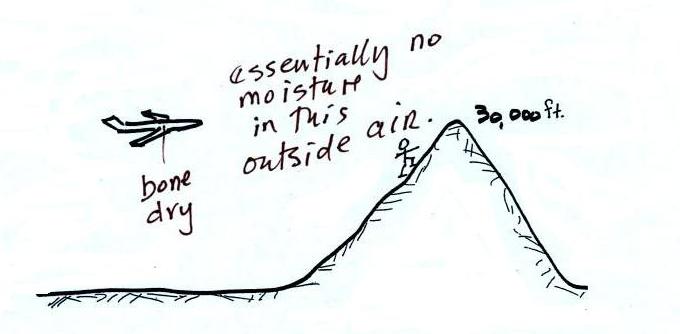
The air in an airplane comes from
outside the plane. The air outside the plane
can be very cold (-60 F perhaps) and contains very
little water vapor (even if the -60 F air is
saturated it would contain essentially no water
vapor). When brought inside and warmed to a
comfortable temperature, the RH of the air in the
plane would be essentially 0%. The RH doesn't
get this low because the airplane adds moisture to
the air to make to make the cabin environment
tolerable. Still the RH of the air inside the
plane is pretty low and passengers often complain of
dehydration
on long airplane flights. This
may increase the risk of catching a cold (ref)
I'm not sure at
this point whether we'll have time for the
following on Tuesday
The rain-shadow effect
Next a much more important example of drying
moist air (see p. 88 in the photocopied
ClassNotes).
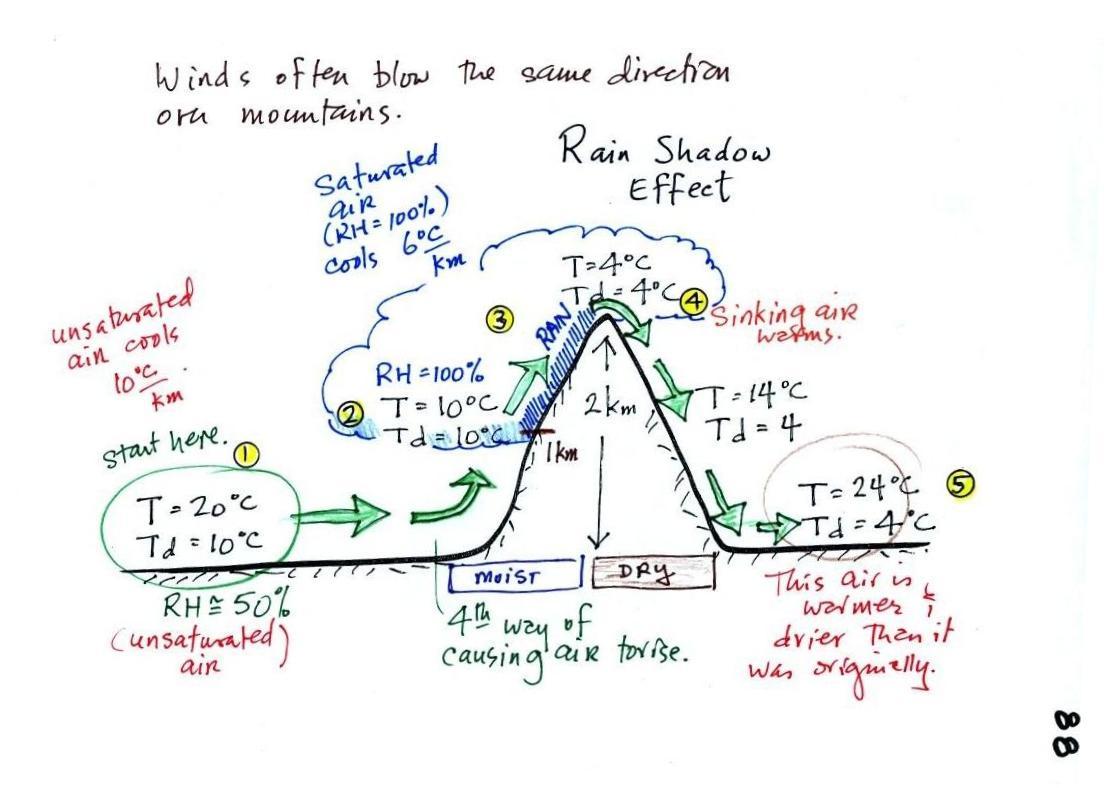
We start with some moist but unsaturated air
(the RH is about 50%) at Point 1 (the air and dew point
temperatures would need to be equal in order for the air
to be saturated).
As it is moving toward the right the air runs into a
mountain and starts to rise (this is the 4th way of
causing rising air motions). Rising air expands
and cools. Unsaturated air cools 10 C for every
kilometer of altitude gain (this is known as the dry
adiabatic lapse rate but isn't something you need to
remember). So after rising 1 km the air will cool
to 10 C which is the dew point.
The air becomes saturated at Point 2 (the air
temperature and the dew point are both 10 C).
Would you be able to tell if you were outdoors looking
at the mountain? Yes, you would see a cloud
appear.
Now that the RH = 100%, the saturated air cools at a
slower rate than unsaturated air (condensation of water
vapor releases latent heat energy inside the rising
volume of air, this warming partly offsets the cooling
caused by expansion). We'll use a value of 6 C/km
(an average value). The air cools from 10 C to 4 C
in next kilometer up to the top of the mountain.
Because the air is being cooled below its dew point at
Point 3, some of the water vapor will condense and fall
to the ground as rain. Moisture is being removed
from the air and the value of the mixing ratio (and the
dew point temperature) decreases.
At Point 4 the air starts back down the right side of
the mountain. Sinking air is compressed and
warms. As soon as the air starts to sink and warm,
the relative humidity drops below 100% and the cloud
disappears. The sinking unsaturated air will warm
at the 10 C/km rate.
At Point 5 the air ends up warmer (24 C vs 20 C) and
drier (Td = 4 C vs Td = 10 C) than when it started
out. The downwind side of the mountain is referred
to as a "rain shadow" because rain is less likely there
than on the upwind side of the mountain. Rain is
less likely because the air is sinking and because the
air on the downwind side is drier than it was on the
upslope side.
This is topographic lifting, the 4th of 4 processes
that can cause air to rise. The other three were:
convergence (surface winds spiraling inward toward a low
pressure center will rise), fronts (both warm and cold
fronts cause air to rise), and convection (warm air
rises).
|
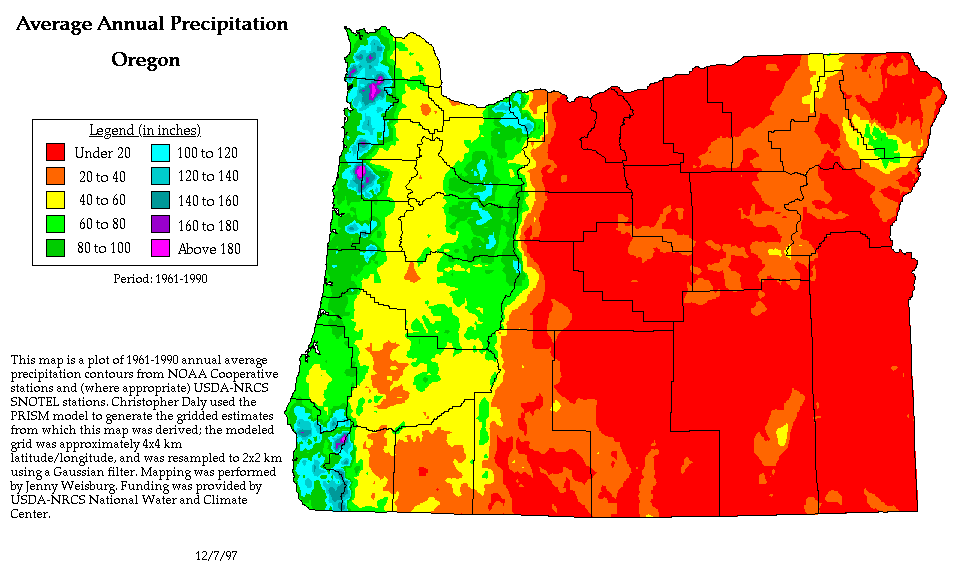 |
We can see the effects of a rain shadow
illustrated well in the state of Oregon. The
figure above at left shows the topography (here's the source
of that map). Winds generally blow from
west to east across the state.
Coming off the Pacific Ocean the winds first encounter a
coastal range of mountains. On the precipitation
map above at right (source)
you see a lot of greens and blue on the western sides of
the coastal range. These colors indicate yearly
rainfall totals that range from about 50 to more than
180 inches of rain per year. Temperate rainforests
are found in some of these coastal locations. The
line separating the green and yellow on the left side of
the precipitation map is the summit, the ridgeline, of
the coastal mountain range.
That's the Willamette River valley, I think, in between
the coastal range and the Cascades. This valley is
somewhat drier than the coast because air moving off the
Pacific has lost some of its moisture moving over the
coastal range.
What moisture does remain in the air is removed as the
winds move up and over the taller Cascades. The
boundary between yellow/green and the red is the
ridgeline of the Cascade Mountains.
Yearly rainfall is generally less than 20 inches per
year on the eastern side, the rain shadow side, of the
Cascades. That's not too much more
than Tucson which averages about 12 inches of rain a
year.
Death valley is
found on the downwind side of the Sierra Nevada
mountains (source of
left image).
The Chihuahuan desert and the
Sonoran desert are found downwind of the Sierra
Madre mountains in Mexico (source
of the right image).
Mexico
might be a little harder to figure out because moist air can
move into the interior of the country from the east and west
at different times of the year. But there are
mountains along both coasts, so some of that moisture will
be removed before arriving in the center of the county.
Most of the year, the air that arrives
in Arizona comes from the west, from the Pacific Ocean
(this changes in the summer). It usually isn't
very moist by the time it reaches Arizona because it has
traveled up and over the Sierra Nevada mountains in
California and the Sierra Madre mountains further south
in Mexico. The air loses much of its moisture on
the western slopes of those mountains.
Beginning in early July in southern Arizona we start to
get air coming from the south or southeast. This
air can be much moister and leads to development of our
summer thunderstorms.
Just as some of the world's driest regions
are found on the downwind side (the rain shadow side) of
mountain ranges, some of the wettest locations on earth
are on the upwind sides of mountains. There seems
to be some debate whether Mt.
Wai'ale'ale in Hawaii or Cherrapunji
India gets the most rain per year. Both get
between 450 and 500 inches of rain per year.



